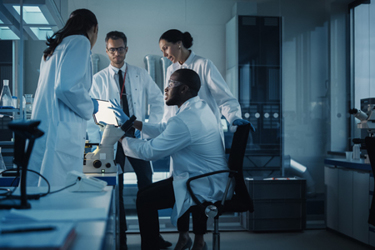Venture Philanthropy For Duchenne Muscular Dystrophy
By Bradley Hodges, Michael Kelly, and Lianna Orlando, CureDuchenne

How CureDuchenne Ventures builds and supports next generation therapies for a rare neuromuscular disorder
Duchenne muscular dystrophy (DMD) is a severe muscle wasting disease that principally affects boys in early childhood. Boys can walk, may appear clumsy and become easily fatigued. Mobility is lost in mid to late teens, scoliosis and bone fractures are common, and respiratory and cardiac function declines. DMD is ultimately fatal, with most young men passing in their second or third decade due to cardiopulmonary collapse.
Although all cases of DMD are caused by mutations in a single gene, DMD has proven to be a very challenging disease to treat. The affected gene encodes a very large cytoskeletal protein, called dystrophin, which is critical for muscle health and strength. While replacing or restoring dystrophin via genetically targeted therapies has long been considered a promising approach, the large muscle mass in the body and the high doses needed for efficacy are stretching the limits of safety and the costs of manufacturing.
Despite these challenges, tremendous progress has been made over the past few years developing experimental therapies aimed at the root cause of the disease. Here we will review a number of these advancements and how diseased-focused venture investing can help drive development of next generation therapies.
Looking back, scientific investigation into a better understanding of DMD has been vibrant. Early research was largely funded through parent-driven Duchenne advocacy organizations and government funding, leading to improved preclinical models, and a detailed understanding of disease progression and its natural history. This provided critical insight for advancing the first programs into the clinic.
CureDuchenne was formed nearly 20 years ago by Debra and Paul Miller, parents with the passion to find a cure for their son and the tens of thousands of other boys affected by DMD. As new therapeutic strategies and maturing data in the disease grew over time, funding assistance from CureDuchenne Ventures (CDV) helped compel biotech and pharma companies to investigate their own therapeutic programs for DMD.
CDV, like other VCs, funds throughout a range of stages. For example, we have helped academic discoveries find their home in newly formed companies, cultivated the company startup phase, and prepared it for follow-on funding or corporate partnerships.
CDV is also often a valued syndicate partner at seed and Series A funding rounds, where, in addition to capital, we provide expertise for de-risking DMD projects towards key inflection points. All of this is critical for cultivating more “shots on goal” in terms of DMD therapies. CDV has funded more than 44 projects designed to target various aspects of the disease process, and our efforts have leveraged nearly $3 billion in follow-on investments in DMD from venture capital, biotech and pharma companies. Importantly, our investment in new and transformative technologies illustrates our desire to think differently and put patients first.
Progress in Duchenne Therapeutic Development
Early efforts to target the genetic basis of DMD have evolved into the current gene therapies and exon skipping approaches in clinical trials today. Likewise, more refined therapeutic efforts to minimize inflammation and other secondary manifestations of the disease are being explored. While the current generation of therapies aim to improve upon the shortcomings of previous efforts, CDV is focused on the gaps in therapy, and putting significant effort and funds towards those unmet needs. In particular, muscle targeting is critically needed to reduce dose and off-target exposure, and to improve long-term safety and efficacy.
Exon Skipping
Exon skipping technology aims to circumvent the effects of DMD-causing mutations by reframing the dystrophin mRNA so that a smaller, yet functional, protein can be formed. Some of CureDuchenne’s earliest support of research was in exon skipping programs, including a grant in 2010 which ultimately led to Sarepta Therapeutics’ Exondys 51, the first drug ever approved for DMD in the US. Returns from other early investments (e.g. in Prosensa’s drisapersen) helped enable later investments in Avidity Biosciences, Dyne Therapeutics, PepGen, and Entrada Therapeutics, each developing next generation exon skipping drugs with the goals of improving muscle targeting and efficacy. Importantly, these second-generation exon skipping therapies target the heart as well as skeletal muscle. Exon skipping approaches, however, are specific for select subtypes of mutations, and thus will not work for all individuals with DMD. While advances in multi-exon skipping efforts may help address this limitation, other approaches, such as gene therapy, aim to be more mutation-agnostic.
Gene Therapy
The goal of DMD gene therapy is to deliver the instructions for making a functional copy of a dystrophin protein. This theoretically could work for individuals with any type of DMD mutation. However, the full-length dystrophin gene does not fit within the AAV virus currently used to deliver these therapies to muscle, so a number of smaller dystrophin transcripts have been created with the goal of restoring some of the most critical functions of full-length dystrophin.
Clinical trials evaluating the systemic delivery of these microdystrophins to muscle cells are showing very promising results. CDV made an early investment in Bamboo Therapeutics’ microdystrophin gene therapy program, which was subsequently acquired by Pfizer. This program is currently in Phase III worldwide registration trials.
We also supported work at Nationwide Children’s from 2010-2017 to develop a novel AAV-based U7 exon skipping for rare exon-2 duplications. This work recently demonstrated, for the first time, the clinical restoration of full-length dystrophin in three individuals, including a baby treated at 7 months old. Such U7- based constructs are small RNAs, and potentially could be engineered to skip multiple exons.
Gene Editing
Gene editing provides the opportunity to permanently correct mutations in the dystrophin gene. In 2017, CDV co-founded Exonics Therapeutics, which used an AAV to deliver CRISPR Cas9 technology to enable permanent corrections of exon-51 on the gene encoding dystrophin. This technology offers the promise of a single dose, permanent correction of the faulty dystrophin gene, and key preclinical studies in the DMD dog model showed restoration of dystrophin by as much as 92% of normal levels following a single treatment. Vertex acquired Exonics in 2019 and is expected to initiate the first gene editing clinical trial for DMD in 2023.
Next-Generation Gene Therapy and Gene Editing: Focus on Delivery
AAV-delivered therapies are not without significant limitations. First, the large muscle mass and the high doses of AAV needed for efficacy stretch their limits of safety and our ability to manufacture on the scale needed to treat all patients. This also impacts the cost of treatment. These issues are compounded when one considers delivering multiple AAVs simultaneously, to encode for larger dystrophin constructs or deliver more precise gene editing technologies. Newer AAVs more trophic for muscle over other tissues (MyoAAVs) could make dual AAV delivery a real possibility.
Moreover, preexisting neutralizing antibodies to natural AAV infection could exclude 30-50% (or more) of potentially treatable individuals from trial participation. In addition, the durability of these therapies (how long they will last) is also unknown. This raises the probability that the effect may wane over time, especially in individuals treated at a very young age and before they have developed much of their muscle mass. Novel approaches that allow first and second administration of AAV in the face of high neutralizing titers is a critical need within the DMD community, and indeed also for other therapies that rely on AAV. CDV has invested in companies such as Chameleon Biosciences aiming to evade neutralizing Abs to AAV, improve efficacy and safety, and broaden the therapeutic reach to treat more patients. CDV is also supporting promising initiatives intended to prevent neutralizing antibody formation following AAV administration using approved immunosuppressives.
Lastly, although still at only early stages of development, the possibility of non-viral delivery is perhaps most intriguing. If able to adequately target muscle cells, non-viral gene delivery could improve upon many of the limitations of viral gene therapy simultaneously: eliminate the issue of pre-existing immunity to AAVs, reduce immune system complications triggered by high viral doses, and allow for redosing. Non-viral delivery may also overcome the limited packaging size of an AAV, and potentially allow for the delivery of full-length dystrophin. It is not yet clear how effective the microdystrophins will be at restoring all muscle function, since they lack most of the domains seen in the full-length dystrophin. CDV were early investors in Code BioTherapeutics and Myosana Therapeutics, each developing novel non-viral gene delivery approaches to treat DMD.
Taken together, the goal is not only to deliver full-length dystrophin, but to be able to treat very young patients, without the concern of neutralizing antibodies and the ability to re-dose as needed. These areas of research are expected to be our focus over the next few years, and if successful could lead to transformational changes to therapy, especially when used in conjunction with the broader development of newborn screening for DMD.
Keeping Muscles Healthy: What is New for Disease Modifiers and Steroids
All the therapies targeting dystrophin will work more effectively in muscle cells that are healthy. Steroids, as compounds that dampen chronic inflammation of muscle cells lacking dystrophin, have been clinically proven to slow the progression of DMD, yet their use is associated with severe side effects. Next generation immunomodulatory therapies exhibiting fewer side effects are in late-stage development. For example, clinical results from a novel differentiated steroid derivative suggests a maintenance of the steroid’s anti-inflammatory effect accompanied by a reduction in the typical steroid-like side effects such as growth delay, weight gain, and bone changes.
In addition, a novel approach to modulating myosin and designed to directly reduce muscle cell death is currently in early clinical trials. This work is expected to directly benefit individuals with either Duchenne or Becker muscular dystrophy and could be considered either as a standalone therapy or in combination with the genetic approaches outlined above.
Looking Ahead
The DMD field has come a long way over the past decades. Our focus over the past few years on the next generation exon-skipping agents has seen several companies advance their muscle-targeted, cell-penetrating exon skipping drugs towards the clinic, and if successful, could lead to transformative treatments for a significant number of individuals with DMD.
We also anticipate the approval of the first microdystrophin gene therapy products within the next couple of years. These therapies will help this generation of DMD boys and young men. However, we have more to do to improve these AAV-based products, and CDV has already made investments in companies addressing these challenges. This will remain an important focus in the coming years as well.
The broad range of therapeutic approaches outlined above is expected to play an important role in managing DMD as therapeutics become approved over the next few years, and we envisage a scenario where multiple therapies working together will be needed to treat the whole disease most effectively.
 Bradley Hodges, PhD is Partner at CureDuchenne Ventures, where he supports and expands CureDuchenne’s research investments, including sourcing, evaluating, negotiating and executing transactions aligned with CureDuchenne’s strategic priorities, as well as working with existing portfolio companies. He is the founder of Prothelia, which developed laminin-111, a novel protein replacement for LAMA2 deficient congenital muscular dystrophy and was later acquired by Alexion in 2014 for $150M. After the rights to laminin-111 were returned to Prothelia in 2017, Hodges took over all business development activities, raised a seed round in 2019, rebuilt manufacturing, and closed a $50M series A in 2020. Hodges was a discovery consultant for Third Rock Ventures and other clients, leading the review and prioritization of new research opportunities for companies including Fulcrum, Goldfinch, Valerion and Faze.
Bradley Hodges, PhD is Partner at CureDuchenne Ventures, where he supports and expands CureDuchenne’s research investments, including sourcing, evaluating, negotiating and executing transactions aligned with CureDuchenne’s strategic priorities, as well as working with existing portfolio companies. He is the founder of Prothelia, which developed laminin-111, a novel protein replacement for LAMA2 deficient congenital muscular dystrophy and was later acquired by Alexion in 2014 for $150M. After the rights to laminin-111 were returned to Prothelia in 2017, Hodges took over all business development activities, raised a seed round in 2019, rebuilt manufacturing, and closed a $50M series A in 2020. Hodges was a discovery consultant for Third Rock Ventures and other clients, leading the review and prioritization of new research opportunities for companies including Fulcrum, Goldfinch, Valerion and Faze.
 Michael Kelly, PhD joined CureDuchenne in December 2011 as chief scientific officer. Kelly, a senior pharmaceutical executive, has more than 25 years of experience in drug discovery and development and is responsible for advancing drug development programs and identifying new drug targets that exhibit potential to transform the treatment of Duchenne muscular dystrophy. Before joining CureDuchenne, Kelly served as president and U.S. site head of Renovis, Inc. and has held senior positions at Amgen, Inc., Wyeth (Pfizer) and Wellcome (GlaxoSmithKline). Kelly holds a Ph.D. from the University of Southampton (U.K.), held research positions at the University of Michigan and University of Nottingham, is an inventor on more than 100 patents and is widely published in peer reviewed journals.
Michael Kelly, PhD joined CureDuchenne in December 2011 as chief scientific officer. Kelly, a senior pharmaceutical executive, has more than 25 years of experience in drug discovery and development and is responsible for advancing drug development programs and identifying new drug targets that exhibit potential to transform the treatment of Duchenne muscular dystrophy. Before joining CureDuchenne, Kelly served as president and U.S. site head of Renovis, Inc. and has held senior positions at Amgen, Inc., Wyeth (Pfizer) and Wellcome (GlaxoSmithKline). Kelly holds a Ph.D. from the University of Southampton (U.K.), held research positions at the University of Michigan and University of Nottingham, is an inventor on more than 100 patents and is widely published in peer reviewed journals.
 Lianna Orlando, PhD is CureDuchenne’s VP of Research and part of the CureDuchenne Ventures team, where she identifies and evaluates strategic investments aimed at developing treatments for Duchenne Muscular Dystrophy. Prior to CureDuchenne, Lianna oversaw research grants and venture philanthropy programs at the Muscular Dystrophy Association and at Fidelity Biosciences Research Initiative. Before leaving academia, Lianna was a faculty member in the Neurology Department at Massachusetts General Hospital. She completed her doctorate in Neurobiology from Harvard University, and a special fellowship master’s degree in Medicine from Harvard Medical School. She holds B.S. degrees in Chemistry and in Magazine Journalism from Syracuse University.
Lianna Orlando, PhD is CureDuchenne’s VP of Research and part of the CureDuchenne Ventures team, where she identifies and evaluates strategic investments aimed at developing treatments for Duchenne Muscular Dystrophy. Prior to CureDuchenne, Lianna oversaw research grants and venture philanthropy programs at the Muscular Dystrophy Association and at Fidelity Biosciences Research Initiative. Before leaving academia, Lianna was a faculty member in the Neurology Department at Massachusetts General Hospital. She completed her doctorate in Neurobiology from Harvard University, and a special fellowship master’s degree in Medicine from Harvard Medical School. She holds B.S. degrees in Chemistry and in Magazine Journalism from Syracuse University.
